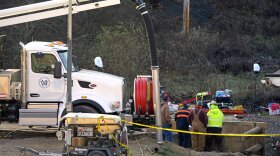The Lewis and Clark expedition is often thought of as a story about the West, but its earliest stages can be traced up the Ohio River to Pittsburgh where Meriwether Lewis set out in a keelboat to meet up with William Clark.
Congress, in passing a major public lands bill last week, will give greater recognition to the first leg of the journey that sought to find a “Northwest Passage” to the Pacific Ocean. The measure includes a provision to extend the Lewis and Clark National Historic Trail from the St. Louis area to Pittsburgh. It now goes to President Trump, and supporters of the project expect he will sign it.
“We’re all excited about this because there are so many people that follow the Lewis and Clark trail from St. Louis all the way to the Pacific,” said Brenda Applegate, executive director of the Beaver County Historical Research and Landmarks Foundation. “We’re hoping that now they will want to come and start in Pittsburgh where the (trip) actually began.”
The existing trail runs from St. Louis and ends at the mouth of the Columbia River separating Oregon from Washington state. It’s not one continuous pathway to, say, hike or bike. Rather, it’s a route administered by the National Park Service with historical markers, museums and recreational opportunities along the way.
Many history textbooks teach that the expedition began in 1804 when Lewis and Clark took off from St. Louis up the Missouri River through the newly purchased Louisiana Territory, a broad swath of land previously owned by France in the middle of the present-day United States.
In fact, Pittsburgh can also lay claim to the start of the journey. It’s where Lewis received a letter from Clark confirming that he would join the expedition. Lewis had to wait here for over a month while a craftsman built his keelboat that would carry the Corps of Discovery and their supplies on the expedition.
“The boatbuilder was a drinking man, so he seldom worked mornings, and sometimes not in the afternoons either,” wrote Stephen E. Ambrose in the book “Undaunted Courage,” which chronicles the expedition. “He had none of Lewis’s sense of urgency. But there was no one else in Pittsburgh capable of doing the work. So Lewis fretted and fumed but did not fire the contractor.”
Finally at the end of August 1803, Lewis set out to meet up with Clark at the falls of the Ohio River in Clarksville, Indiana. He stopped briefly that first day on Brunot Island. He was showing off his rifle, passing it around to the residents who’d gathered, when it accidentally discharged and narrowly avoided killing a woman.
Applegate said an interpretive sign will go in this summer on Mount Washington overlooking Brunot Island. It follows others installed in 2014 and 2015 at nearby sites relevant to the Lewis and Clark journey.
Applegate said markers like that give a boost to tourism in western Pennsylvania.
“The closer we connect the dots, people are more apt to follow from one location to the other,” she said.
Paige Cruz of West Virginia, who chairs the Lewis and Clark Trail Heritage Foundation’s eastern legacy committee, has pushed for the federal government to extend the trail designation.
“A lot of facilities already exist along the Ohio River that have to do with Lewis and Clark,” she said.
But it wasn’t until the 200-year celebration of the Lewis and Clark expedition in the early 2000s that momentum started to build around a more formal recognition of the early part of the journey.
“A lot of these groups that had participated in the commemoration realized how important the Lewis and Clark journey was in the east,” Cruz said.
The National Park Service completed a study last year to identify the extension route. That study led to the provision included in the Natural Resources Management Act that cleared Congress last week. In addition to granting the trail extension, the bill also reauthorizes the Land and Water Conservation Fund, which provides grants for parks and other green spaces in every state. That fund had expired last year.




